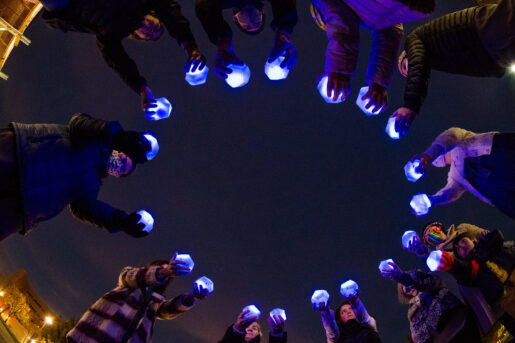Melany Nugent-Noble Explores the Poetics of Connection with Participatory Artwork
Posted on | Updated
When it is necessary to stand still aims to draw people out of their routines, create curiosity about community and elevate the mundane.
A small, angular beacon rests in your hand. As you move through your city, it changes colour. You know that as it does so, it’s telling you something. Because there are other beacons out there, in hands a lot like yours.
Growing dimmer means you’ve gotten further away from those other beacons. Colours change depending on how many others are nearby. A brighter gleam shows you’re getting closer to one another. When all gathered together in one place, the beacons will glow bright white.
For artist Melany Nugent-Noble (MFA 2015), bringing this dreamlike scene to life has been the work of years. And as Kelowna’s first artist-in-residence, the project will finally find a public audience; beginning at the end of August, Melany’s latest participatory artwork, When it is necessary to stand still, will see 25 beacons distributed to participants in the lakeside city for ten separate three-day “activations.”
Once in possession of a beacon, participants will interact with the object as they please. Wandering around Kelowna, they’ll find their beacon glowing or dimming as they grow nearer or more distant from fellow participants. Melany says the extraordinary openness of this proposition fosters a kind of intimacy between a person and their beacon, and between beacon-holders.
“In a way it's a really simple project: these beacons change colour,” she says. “But in my experience, people really emotionally connect with them. Then there’s community engagement and community capacity building. So, it works on the level of the individual, the level of community, and then possibly on an interpersonal level.”
"The context allows people to step out of their routine ... They’re given permission for some sort of agency."
Melany’s hedging on any definitive claim that participation guarantees one-on-one interactions stems from her acknowledgment that “people may just want to engage with it as a lamp.” And for her, giving participants agency to engage or disengage is part of the premise.
“Really, it's a conceptual game. People are carrying these beacons around. Even the shape of them, they're like game pieces,” she says. “But also, the context allows people to step out of their routine, gives them agency to look beyond their typical boundaries, and maybe do things or talk to someone who’s in the game, which they may not necessarily do in their day-to-day. They’re given permission for some sort of agency.”
The work began during Melany’s MFA studies at Emily Carr University, where she says ECU associate professor Justin Langlois was key in helping her develop the project. Its earliest iterations were conducted as a research project called Invisible threads are the strongest ties. But the upcoming activation as part of Kelowna’s public art program will represent its large-scale debut. (Melany notes the feasibility of rolling the work out in August will depend on whether the public can safely participate, given COVID-related health risks).
Inside the beacon itself is a densely packed technological heart. Chips and batteries connect the objects to cellular towers, allowing them to find each other in space. But this profoundly modern functionality is housed within a shell that gestures back millennia. In fact, the shape of the beacon — a dodecahedron, or, twelve pentagons fit together to make a three-dimensional, semi-spherical form — is connected to some of the earliest attempts to understand the universe, says Melany.
“Plato said that the dodecahedron was the shape of the universe, linking it to the 12 constellations,” she says. “It's an interesting, eternal, universal, beautifully mathematical shape.”
A dodecahedron is also difficult to make, Melany adds. There were many early prototypes, including editions made of veil-thin cedar. And while the technology that allows the beacons to communicate may seem complex, Melany says figuring out how to make the shells was “one of the simplest but one of the hardest parts” of the project.
Some of Melany’s excitement about the project’s upcoming launch is precisely because she’ll be able to put aside planning for a moment, and focus on the magic of people connecting.
“It's easy to get lost in the minutiae of logistics, and getting it to work,” she says. “That’s one reason I'm so excited about this part: to give space for whatever those poetics are to come to life.”
You can find out more about When it is necessary to stand still on Melany’s website, or delve into some of her earlier research via the Invisible threads are the strongest ties Instagram. Melany will also be documenting the upcoming Kelowna activations, including the voices of community participants, on her personal Instagram, where you can follow along.
